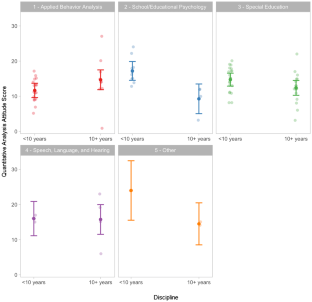Abstract
Single-case experimental designs (SCEDs) are a useful tool for evaluating the effects of interventions at an individual level and can play an important role in the development and validation of evidence-based practices. Historically, researchers relied on visual analysis of SCED data and eschewed statistical approaches. Although researchers increasingly include quantitative analysis in SCED research, it does not appear as though there is a consensus in the field regarding the role of quantitative analysis of SCED data. Using a survey of researchers with published SCED studies, this study provides preliminary evidence of the range of researchers’ opinions about quantitative analysis of SCED data. The results suggest that there is a broad range of opinions regarding the role of quantitative analysis of SCED data among active SCED researchers. Some of the differences may be attributable to field of study and years of experience.

Similar content being viewed by others
References
Baer, D. M. (1977). Perhaps it would be better not to know everything. Journal of Applied Behavior Analysis, 10, 167–172.
Behavior Analyst Certification Board. (2012). BCBA/BCaBA task list (4th ed.). Littleton: Authors.
Benjamini, Y., & Hochberg, Y. (1995). Controlling the false discovery rate: a practical and powerful approach to multiple testing. Journal of the Royal Statistical Society: Series B, 57, 289–300.
Bloom, M., & Fisher, J. (1982). Evaluating practice: Guidelines for the accountable professional. Englewood Cliffs: Prentice Hall.
Council for Exceptional Children. (2015). What every special educator must know: Professional ethics and standards. Arlington: CEC.
DeProspero, A., & Cohen, S. (1979). Inconsistent visual analysis of intrasubject data. Journal of Applied Behavior Analysis, 12(4), 573–579.
Fisch, G. S. (2001). Evaluating data from behavioral analysis: visual inspection or statistical models? Behavioural Processes, 54, 137–154.
Ford, A. L., Rudolph, B. N., Pennington, B., & Byiers, B. J. (2019). An exploration of the interrater agreement of visual analysis with and without context. Journal of Applied Behavior Analysis. https://doi.org/10.1002/jaba.560.
Horner, R. H., Carr, E. G., Halle, J., McGee, G., Odom, S., & Wolery, M. (2005). The use of single-subject research to identify evidence-based practice in special education. Exceptional Children, 71(2), 165–179.
Jones, R. R., Weinrott, M. R., & Vaught, R. S. (1978). Effects of serial dependency on the agreement between visual and statistical inference. Journal of Applied Behavior Analysis, 11, 277–283.
Kazdin, A. E. (1976). Statistical analyses for single-case experimental designs. In M. Hersen & D. H. Barlow (Eds.), Single-case experimental designs: Strategies for studying behavior change (pp. 265–316). Oxford: Pergamon Press.
Kratochwill, T. R., Hitchcock, J., Horner, R. H., Levin, J. R., Odom, S. L., Rindskopf, D. M. & Shadish, W. R. (2010). Single-case designs technical documentation. Retrieved from What Works Clearinghouse website: http://ies.ed.gov/ncee/wwc/pdf/wwc_scd.pdf.
Manolov, R., Gast, D. L., Perdices, M., & Evans, J. J. (2014). Single-case experimental designs: Reflections on conduct and analysis. Neuropsychological Rehabilitation, 24, 634–660. https://doi.org/10.1080/09602011.2014.903199.
National Association of School Psychologists. (2010). Standards for graduate preparation of school psychologists. Retrieved from www.nasponline.org/standards-and-certification.
Park, H., Marascuilo, L., & Gaylord-Ross, R. (1990). Visual inspection and statistical analysis in single-case designs. The Journal of Experimental Education, 58, 311–320. https://doi.org/10.1080/00220973.1990.10806545.
R Core Team. (2015). R studio: Integrated development for R. Boston: R Studio, Inc.
Ross, S. G., & Begeny, J. C. (2014). Single-case effect size calculation: Comparing regression and non-parametric approaches across previously published reading intervention data sets. Journal of School Psychology, 52, 419–431. https://doi.org/10.1016/j.jsp.2014.06.003.
Scruggs, T. E., Mastropieri, M. A., & Casto, G. (1987). The quantitative synthesis of single-subject research: Methodology and validation. Remedial and Special education, 8(2), 24–33.
Shadish, W. R., & Rindskopf, D. M. (2007). Methods for evidence -based practice: Quantitative synthesis of single-subject designs. New Directions for Evaluation, 2007(113), 95–109.
Sharpley, C. (1981). Visual analysis of operant data : Can we believe our eyes? Australian Behaviour Therapist, 8, 13–21.
Smith, J. D. (2012). Single-case experimental designs: A systematic review of published research and current standards. Psychological Methods, 17, 1–70. https://doi.org/10.1037/a0029312.
Acknowledgements
This paper is the product of a graduate seminar in the Special Education Program in the Department of Educational Psychology at the University of Minnesota. The authors declare that there are no conflicts of interest.
Author information
Authors and Affiliations
Corresponding author
Additional information
Publisher's Note
Springer Nature remains neutral with regard to jurisdictional claims in published maps and institutional affiliations.
Rights and permissions
About this article
Cite this article
Byiers, B.J., Pennington, B., Rudolph, B.N. et al. Perspectives on the Use of Quantitative Analysis in Single-Case Experimental Research. J Behav Educ 30, 444–454 (2021). https://doi.org/10.1007/s10864-020-09386-2
Published:
Issue Date:
DOI: https://doi.org/10.1007/s10864-020-09386-2




